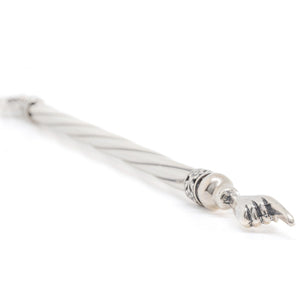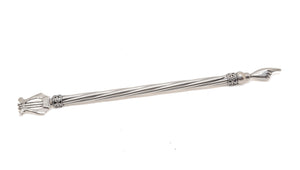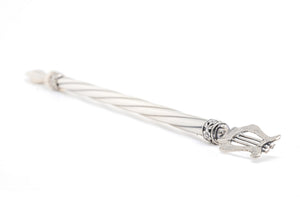Your Cart is Empty
Free shipping on orders over $300



JUD00331
The yad is a tool part of the kele kodesh, the holy vessels that adorn the Torah, the sacred text of Judaism. Yad in Hebrew literally means “hand”: they are in fact pointers for reading the Torah, which usually end up in a shape of a closed hand with the index finger extended.
The origin of the yad is uncertain: some sources date it back up to the year 130. It is said that during the third Jewish war, also known as Bar Kokhba revolt, the teachers of the schools in the city of Bethar, before its destruction, were using it as a weapon against enemies.
Its widespread distribution as a worship instrument, with its current features, however, began in Europe in the fifteenth and sixteenth century and quickly involved all the Jewish communities of the continent. Its function in the Jewish ritual is fundamentally linked to a practical necessity: enable the reader of the Torah’s rolls to scroll the text respecting the prohibition to touch the Holy Scriptures with his hands. The final part, shaped as a hand with the index finger extended, is then the replacement of the gesture that makes the reader to keep the sign on the text which he’s reading.
The reader of the Torah can be guided in reading independently with the yad, or – and it is the most common practice – let a second person, the Segan (the representative of the congregation) to indicate with the yad the point of the text to read, avoiding possible errors.
From the aesthetic point of view, the pointers have some common characteristics: a length of around 30 cm and the stick form that narrows until it assumed the shape of the hand. However, the stylistic variations are various, both from the perspective of the material – mainly of silver, but also in wood – both of the decorations and finishes, mostly related to the influences of the geographical areas of origin.
There are so models covered with gold or jewelry, with spiral forms, others decorated with geometric designs. Often yad presents engravings of biblical verses or the name of the donor. Even the hand shapes are very different: from the classical with the index finger extended, to those with the hand fully open or fully closed to form a fist.
In essence, the yad are well far from having a standardized form. This is indeed their variety that makes them very interesting objects for antiques collectors and enthusiasts.